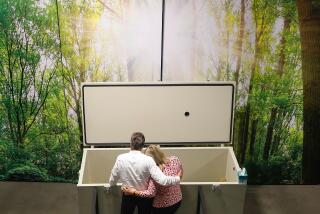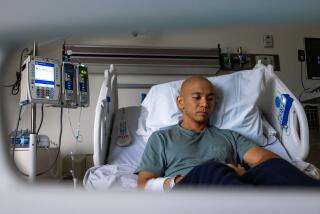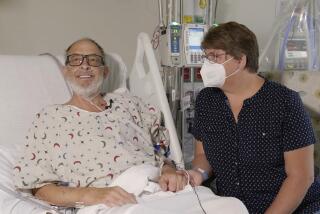A Heartfelt Revolution : 20 Years After Christiaan Barnard’s Pioneering Transplant, the Quest Now Is for Enough Donors
- Share via
Seven-year-old Kari Reynolds will have visitors today. Not just her mother, Pam, but two other women who will stop by her room and try to coax a smile or a wave from the frail little heart transplant patient.
The women, Cheryl Westlake, 28, and Jackie Wilmarth, 37, are UCLA’s heart transplant coordinators, a relatively new breed of medical personnel.
Seeing patients like Kari, they will tell you, “is how we get our rewards.”
The little girl, who at birth was given 24 hours to two weeks to live, had three heart operations before she received a donor heart at UCLA Medical Center on Nov. 18. Now she plans to be home to celebrate her eighth birthday on Dec. 18.
Coordinating Complex Steps
As heart transplant coordinators, Westlake and Wilmarth are responsible for coordinating the complex scientific and logistical steps that must be taken before a recipient, often hanging on to life by a thread, can be matched with an appropriate donor--who may be in another state.
They work against the exigencies of time, distance and the disappointment of finding that a match between potential donor and recipient is almost, but not quite, good enough. They wear beepers and are on call most of the time, even on weekends. They often work 20-hour days, on a precise schedule. A heart available for transplant can only last four hours without blood and oxygen.
The fact that their jobs even exist shows how commonplace heart transplants have become in the 20 years since Dr. Christiaan Barnard gave the world its first, implanting the heart of a 25-year-old accident victim into a 55-year-old man in Cape Town, South Africa, on Dec. 3, 1967. The patient lived only 18 days, but the then-experimental procedure revolutionized heart surgery for patients with end-stage heart disease.
Now, officials at most established heart transplant centers report a survival rate of 80% to 100% one year after transplantation; 65% of recipients will be alive at the five-year mark. The longest heart transplant survivor in the U.S. is a Stanford University School of Medicine heart recipient who has lived 18 years since his transplant and is leading a normal functional life at age 58.
‘Pretty Routine Now’
“I think we’ve made some quantum leaps since that initial surgery 20 years ago,” said Dr. Leonard Bailey, 44, the pioneering pediatric heart surgeon at Loma Linda University.
“It’s pretty routine now,” Bailey said of heart transplants. “And it is excellent therapy in the long term.”
“There has been an acceptance in the last few years (of heart transplants) as a standard form of therapy by the medical profession and by third-party payers (insurance companies),” said Dr. John Baldwin, director of Stanford’s heart-lung transplant program. “It’s a proven form of therapy not being thought of as experimental anymore.”
Yet, as the number of heart transplants increases each year--it is estimated that more than 1,000 will be performed in 1987, and the projected need is for 15,000 annually--the number of donors is not increasing by the necessary percentages. Stanford researchers predict a donor supply of about one-tenth of the yearly need.
Stress of Excess Need
For people such as Westlake and Wilmarth--who work daily with heart transplant recipients before and after their transplants--the gap between supply and demand is an ever-present source of stress.
“They will call you at home, just because they’re getting so frustrated,” Westlake said of prospective heart recipients. “You can imagine if your life is depending on a transplant and weeks and months keep going by. You get loony-toony. You get stressed.”
Sometimes the two, both cardiopulmonary nurses with master’s degrees, have to stay awake and functioning at the hospital for three straight days, if they have three back-to-back heart transplant surgeries as Westlake did in January.
Then Westlake was working alone, on call seven days a week. Wilmarth was hired two months ago, so each woman now gets some time off.
When Westlake and Wilmarth hear from an Organ Procurement Agency that a heart is going to be available, their schedule goes something like this:
They check numerous records--blood type, height, weight comparisons--of donor and possible recipient and call the surgeons. If the surgeons approve the match, the coordinators work with the donor’s medical staff, and UCLA’s. They schedule operating rooms, alert the nursing staff, the laboratory, the blood bank and psychiatrists who will assess the patient’s mental state, and notify the proposed recipients to come to the hospital. UCLA’s potential heart recipients who are well enough to remain at home before transplant surgery are equipped with beepers.
Several Transplant Teams
Westlake and Wilmarth often coordinate five or six different transplant teams, if the brain-dead donor also has agreed to donate lungs, kidneys, liver, pancreas or corneas, in addition to the heart. There must be a helicopter to bringthe heart of a nearby donor to UCLA Medical Center, which began its heart transplant program in 1984. Often a Lear jet is dispatched to some other Western state for the donor heart.
Even after the patients are recovered and can leave the hospital, Westlake and Wilmarth see them twice a week.
“The job is very stressful, not just because of the timing and logistics of it,” said Westlake. She was a critical-care nurse and instructor at Los Angeles County USC Medical Center before taking the heart transplant job at UCLA 13 months ago.
“But you become involved with these patients. We monitor them forever. And they’re like family to you. . . . You are their link to UCLA, and UCLA is their life. It gave them their heart.”
A routine heart transplant operation lasts 4 to 6 hours and costs $50,000 to $150,000. Medicare has recently approved payments to several heart transplant centers across the country. Stanford Medical Center is the only Medicare-approved one in California, but UCLA has applied for approval.
In 1984, Loma Linda’s Bailey made world history and stirred a medical uproar when he implanted the heart of a baboon into a newborn baby girl. Known as Baby Fae, she died 20 days later.
Bailey said he plans to pursue cross-species transplants, particularly focusing on using baboon hearts for pediatric patients.
Prefers Mechanical Hearts
“I think we will get farther with the simian donors than (with) other forms of animals,” he explained.
But he added that he believes the future of heart transplants for adults lies in the improvement of mechanical hearts.
“Within the decade, I think we will see mechanical implants, and should that come true, it will impact adult transplantation, and more realistically fulfill the demand. More people die waiting for transplants than die after transplantation.”
American heart transplant surgeons credit the introduction of cyclosporine with keeping organ transplant patients alive and in better health for a longer period. The drug suppresses the immune system response and prevents organ rejection. Cyclosporine was approved by the Food and Drug Administration in 1983.
‘Made a Big Difference’
“Cyclosporine made a big difference,” said Dr. Christiaan Barnard, now 65 and a scientist in residence at the Oklahoma Transplant Institute of the Baptist Medical Center in Oklahoma City.
“The (biggest) advances have been in early diagnosis of rejection and the use of immunosuppression drugs.”
Barnard, who has retired from the operating room because of debilitating arthritis, now works in research, patient selection and post-operative management. He also spends much time, he said in a telephone interview, talking with groups about the need for donors.
Barnard believes that “once we conquer rejection, we will move to the use of animal hearts,” but he is not in favor of using simian donors.
“I used a baboon once, and then a chimpanzee and it was a traumatic emotional experience,” he said. “I am not in favor of using the higher forms like the chimpanzee. Not the apes, they are pretty human, and the bigger ones are already in danger of becoming extinct. I would favor using (domesticated) animals about to be slaughtered.”
More Xenografts Ahead
Stanford’s Baldwin believes there will more more xenografts, or cross-species transplants, in the future, “as the immunosuppressive drugs become more sophisticated and less toxic.
“Many people have pig valves,” said Baldwin, “so the precedent for use of animal tissue is well established. The important social and ethical issues will have to be decided by society.”
Stanford’s is the oldest heart transplant center in the United States. Its Dr. Norman Shumway performed the country’s first heart transplants in January, 1968. Since then, Stanford heart transplant teams have performed “a little over 500 operations,” more than any other hospital in the world.
But Barnard, Baldwin, Bailey and other heart transplant personnel continue to stress the need for more donors.
People Die Waiting
“People die every week because we can’t find donors,” Baldwin said. “We do about one heart transplant every five days and we would do more if there were more donors. . . . I think there are a lot of reasons we don’t. There isn’t enough public awareness, and we do have a logistics problem; there are fairly severe time constraints.”
Baldwin said he thinks public squeamishness about donating organs has subsided somewhat over the years.
“There is something positive that can come out of it (organ donation) and a lot of families are consoled by that.”
At UCLA, Wilmarth and Westlake agree, the biggest problem is a lack of donors.
Lack of Awareness
“It is lack of public awareness,” said Wilmarth. “And Los Angeles is a multicultural area, so you find some cultural and religious objections.”
“From Aug. 28 to Oct. 29, we did no transplants here,” said Westlake, “because we had no suitable donors. People died, because we just can’t keep them alive long enough. We were lucky with Kari, because we got a heart just in time.”
Kari Reynolds, of Temple City, was so ill she was placed on “urgent” status for a donor heart. She got one in eight days.
“She was almost gone by the time they got a heart for her,” Pam Reynolds said. “I am grateful she lived this long so she could be a part of the transplant system. So she could be here at the right time.”
Waiting List Priorities
“The average wait here is a few days to two months,” said Dr. Hillel Laks, 45, a South African-born surgeon who directs the heart transplant program at UCLA and is about to begin a heart-lung transplant operation.
“We’ve done 35 this year and have 15 on a list now. We have to prioritize according to how sick the patient is.”
Laks said that research is being done that would allow hearts to be kept up to 24 hours for transplant use, instead of four hours. Livers, he explained, now can be kept 8 to 12 hours; kidneys, 24.
“The miracle is seeing a heart coming out of somebody dead (that allows) somebody who surely would have died to live,” Laks said. “Especially someone like Kari, who will be able to lead a normal life.
“There are dangers of rejection and infection until a year. And they cannot deviate from daily medications. But they play sports and do other normal activities. Many go back to work.
“We had a picnic with the transplant patients a few months ago and there was a 66-year-old man who had looked like a corpse and was confined to a wheelchair, unable to do anything. At the picnic he was pitching all afternoon.”






